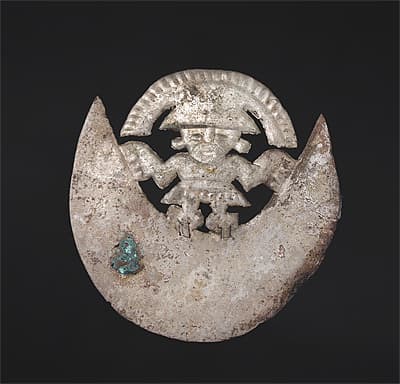
CHIMÚ culture North 1100 – 1470 AD
Nose ornament 1100-1470 AD silver and copper6.9 (h) x 6.8 (w) cm Museo Larco, Lima Photograph: Daniel Giannoni
Chan Chan was the centre of Chimú workshops, which produced more metal objects than any other Peruvian culture. Preferring silver to gold, Chimú smiths used a range of techniques including hammering, repoussé, incising, cutting, filigree and casting. Such knowledge was absorbed by the Incan conquerors who relocated the metalworkers to their capital, Cuzco. The deity figure with a half-moon headdress can be seen on most items of jewellery. The crescent moon symbolised Si, goddess of the moon.
Chan Chan was the centre of Chimú workshops, which produced more metal objects than any other Peruvian culture. Preferring silver to gold, Chimú smiths used a range of techniques including hammering, repoussé, incising, cutting, filigree and casting. Such knowledge was absorbed by the Incan conquerors who relocated the metalworkers to their capital, Cuzco. The deity figure with a half-moon headdress can be seen on most items of jewellery. The crescent moon symbolised Si, goddess of the moon.
Chan Chan was the centre of Chimú workshops, which produced more metal objects than any other Peruvian culture. Preferring silver to gold, Chimú smiths used a range of techniques including hammering, repoussé, incising, cutting, filigree and casting. Such knowledge was absorbed by the Incan conquerors who relocated the metalworkers to their capital, Cuzco. The deity figure with a half-moon headdress can be seen on most items of jewellery. The crescent moon symbolised Si, goddess of the moon.

